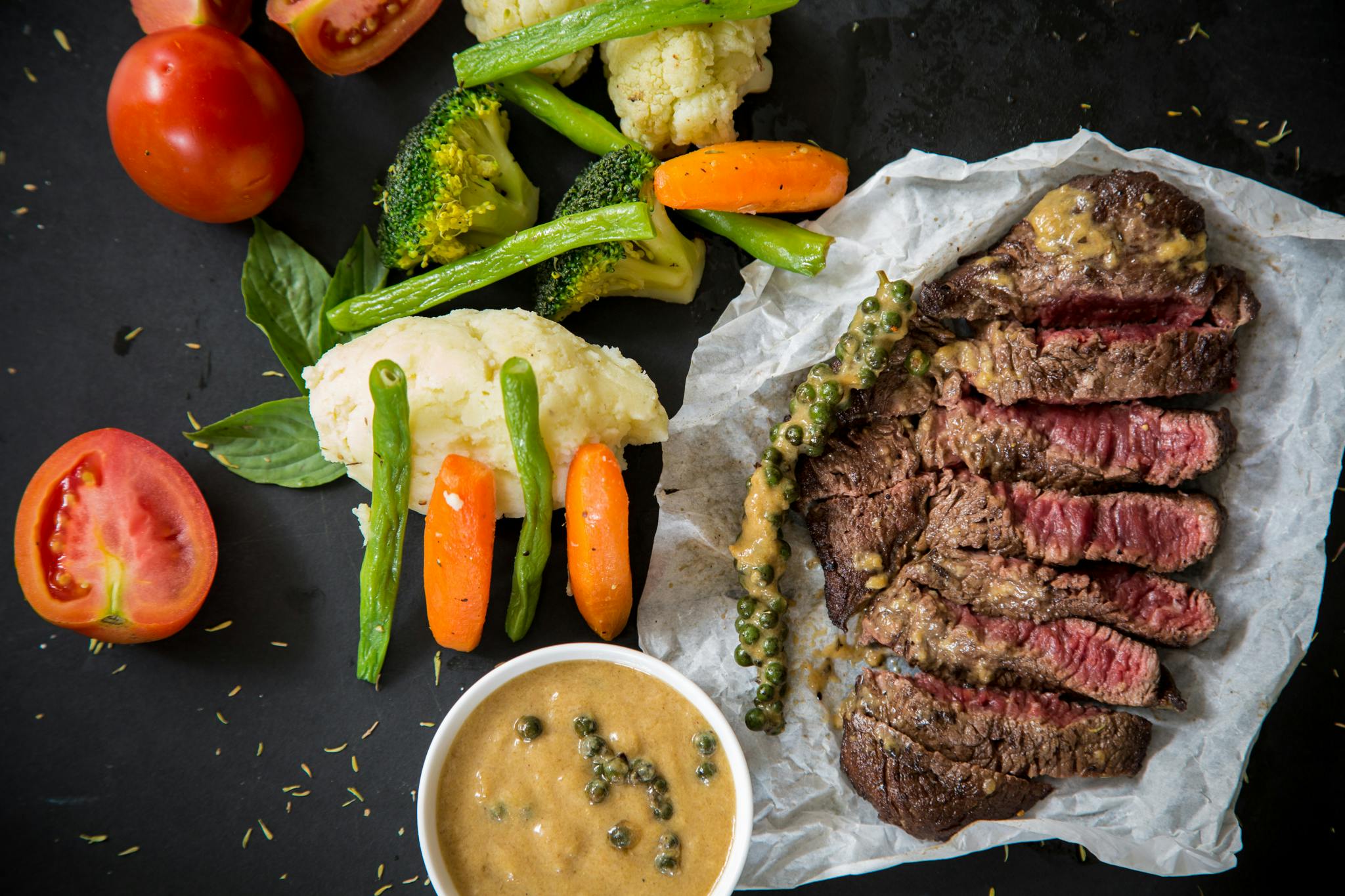Reaching for the salt shaker is often the go-to solution to add flavor to a dish. When reducing salt intake becomes a priority however, a little creativity is called for so you don’t have to compromise on flavor.
The key is to amplify other tastes like acidity, spiciness, and earthiness, using a combination of herbs, spices, vinegars, and juices. Salt? What salt?
Herbs and spices
Besides being sodium-free, herbs and spices are high in antioxidants. They also provide a splash of color, aroma, and flavor to any dish. Popular herbs include parsley, basil, and mint; while common spices often used for seasoning include garlic powder, cumin, and chili powder.
Cooking tip: Dried herbs can be twice as strong as fresh ones. We recommend using ½ teaspoon dried herbs in place of four sprigs of fresh herbs. You can crush dried herbs by hand to release their aromas.
Aromatics
When raw, ginger, garlic, and onion can be sharp and pungent. However they’re fragrant, nutty, and sweet when cooked. Caramelizing aromatics creates umami, one of the five basic tastes that’s known for its savoriness.
Cooking tip: If possible, opt for fresh, raw aromatics instead. They’re less expensive and last longer than pre-chopped.
Vinegar
A splash of vinegar can wake up any dish! It also works well in dressings and for marinades. Experiment with different vinegars like apple cider, red wine, or rice.
Citrus fruits
Citrus fruits are two-in-one flavor bombs, especially lemons and limes. The juice’s acidity and the zest’s aroma and bitterness can be used to flavor almost anything sweet or savory.
Chilies
If you can handle the heat, chilies like fresh jalapeños or smoky chipotles are a tried-and-true method to add a kick of flavor. Even a quick dusting of ground cayenne or chili powder will amp up any dish. If you’re using hot sauce, be sure to check the sodium content.
Reaching for the salt shaker is often the go-to solution to add flavor to a dish. When reducing salt intake becomes a priority however, a little creativity is called for so you don’t have to compromise on flavor.
The key is to amplify other tastes like acidity, spiciness, and earthiness, using a combination of herbs, spices, vinegars, and juices. Salt? What salt?
Herbs and spices
Besides being sodium-free, herbs and spices are high in antioxidants. They also provide a splash of color, aroma, and flavor to any dish. Popular herbs include parsley, basil, and mint; while common spices often used for seasoning include garlic powder, cumin, and chili powder.
Cooking tip: Dried herbs can be twice as strong as fresh ones. We recommend using ½ teaspoon dried herbs in place of four sprigs of fresh herbs. You can crush dried herbs by hand to release their aromas.
Aromatics
When raw, ginger, garlic, and onion can be sharp and pungent. However they’re fragrant, nutty, and sweet when cooked. Caramelizing aromatics creates umami, one of the five basic tastes that’s known for its savoriness.
Cooking tip: If possible, opt for fresh, raw aromatics instead. They’re less expensive and last longer than pre-chopped.
Vinegar
A splash of vinegar can wake up any dish! It also works well in dressings and for marinades. Experiment with different vinegars like apple cider, red wine, or rice.
Citrus fruits
Citrus fruits are two-in-one flavor bombs, especially lemons and limes. The juice’s acidity and the zest’s aroma and bitterness can be used to flavor almost anything sweet or savory.
Chilies
If you can handle the heat, chilies like fresh jalapeños or smoky chipotles are a tried-and-true method to add a kick of flavor. Even a quick dusting of ground cayenne or chili powder will amp up any dish. If you’re using hot sauce, be sure to check the sodium content.
Reaching for the salt shaker is often the go-to solution to add flavor to a dish. When reducing salt intake becomes a priority however, a little creativity is called for so you don’t have to compromise on flavor.
The key is to amplify other tastes like acidity, spiciness, and earthiness, using a combination of herbs, spices, vinegars, and juices. Salt? What salt?
Herbs and spices
Besides being sodium-free, herbs and spices are high in antioxidants. They also provide a splash of color, aroma, and flavor to any dish. Popular herbs include parsley, basil, and mint; while common spices often used for seasoning include garlic powder, cumin, and chili powder.
Cooking tip: Dried herbs can be twice as strong as fresh ones. We recommend using ½ teaspoon dried herbs in place of four sprigs of fresh herbs. You can crush dried herbs by hand to release their aromas.
Aromatics
When raw, ginger, garlic, and onion can be sharp and pungent. However they’re fragrant, nutty, and sweet when cooked. Caramelizing aromatics creates umami, one of the five basic tastes that’s known for its savoriness.
Cooking tip: If possible, opt for fresh, raw aromatics instead. They’re less expensive and last longer than pre-chopped.
Vinegar
A splash of vinegar can wake up any dish! It also works well in dressings and for marinades. Experiment with different vinegars like apple cider, red wine, or rice.
Citrus fruits
Citrus fruits are two-in-one flavor bombs, especially lemons and limes. The juice’s acidity and the zest’s aroma and bitterness can be used to flavor almost anything sweet or savory.
Chilies
If you can handle the heat, chilies like fresh jalapeños or smoky chipotles are a tried-and-true method to add a kick of flavor. Even a quick dusting of ground cayenne or chili powder will amp up any dish. If you’re using hot sauce, be sure to check the sodium content.
Reaching for the salt shaker is often the go-to solution to add flavor to a dish. When reducing salt intake becomes a priority however, a little creativity is called for so you don’t have to compromise on flavor.
The key is to amplify other tastes like acidity, spiciness, and earthiness, using a combination of herbs, spices, vinegars, and juices. Salt? What salt?
Herbs and spices
Besides being sodium-free, herbs and spices are high in antioxidants. They also provide a splash of color, aroma, and flavor to any dish. Popular herbs include parsley, basil, and mint; while common spices often used for seasoning include garlic powder, cumin, and chili powder.
Cooking tip: Dried herbs can be twice as strong as fresh ones. We recommend using ½ teaspoon dried herbs in place of four sprigs of fresh herbs. You can crush dried herbs by hand to release their aromas.
Aromatics
When raw, ginger, garlic, and onion can be sharp and pungent. However they’re fragrant, nutty, and sweet when cooked. Caramelizing aromatics creates umami, one of the five basic tastes that’s known for its savoriness.
Cooking tip: If possible, opt for fresh, raw aromatics instead. They’re less expensive and last longer than pre-chopped.
Vinegar
A splash of vinegar can wake up any dish! It also works well in dressings and for marinades. Experiment with different vinegars like apple cider, red wine, or rice.
Citrus fruits
Citrus fruits are two-in-one flavor bombs, especially lemons and limes. The juice’s acidity and the zest’s aroma and bitterness can be used to flavor almost anything sweet or savory.
Chilies
If you can handle the heat, chilies like fresh jalapeños or smoky chipotles are a tried-and-true method to add a kick of flavor. Even a quick dusting of ground cayenne or chili powder will amp up any dish. If you’re using hot sauce, be sure to check the sodium content.
Reaching for the salt shaker is often the go-to solution to add flavor to a dish. When reducing salt intake becomes a priority however, a little creativity is called for so you don’t have to compromise on flavor.
The key is to amplify other tastes like acidity, spiciness, and earthiness, using a combination of herbs, spices, vinegars, and juices. Salt? What salt?
Herbs and spices
Besides being sodium-free, herbs and spices are high in antioxidants. They also provide a splash of color, aroma, and flavor to any dish. Popular herbs include parsley, basil, and mint; while common spices often used for seasoning include garlic powder, cumin, and chili powder.
Cooking tip: Dried herbs can be twice as strong as fresh ones. We recommend using ½ teaspoon dried herbs in place of four sprigs of fresh herbs. You can crush dried herbs by hand to release their aromas.
Aromatics
When raw, ginger, garlic, and onion can be sharp and pungent. However they’re fragrant, nutty, and sweet when cooked. Caramelizing aromatics creates umami, one of the five basic tastes that’s known for its savoriness.
Cooking tip: If possible, opt for fresh, raw aromatics instead. They’re less expensive and last longer than pre-chopped.
Vinegar
A splash of vinegar can wake up any dish! It also works well in dressings and for marinades. Experiment with different vinegars like apple cider, red wine, or rice.
Citrus fruits
Citrus fruits are two-in-one flavor bombs, especially lemons and limes. The juice’s acidity and the zest’s aroma and bitterness can be used to flavor almost anything sweet or savory.
Chilies
If you can handle the heat, chilies like fresh jalapeños or smoky chipotles are a tried-and-true method to add a kick of flavor. Even a quick dusting of ground cayenne or chili powder will amp up any dish. If you’re using hot sauce, be sure to check the sodium content.





